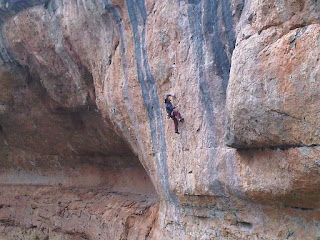A lot of coaching focuses on this as it is obviously a big part of climbing because one falls when pushing to the limit.
However, I would suggest that the standard practice of throwing oneself off the local indoor climbing wall on a regular basis, is only a very small part of truly dealing with the fear of falling. I don't think one can eradicate it completely, and that would be destructive as one taps into that adrenaline anyway for that little bit extra. Fear can be used to drive more effort and focus but will obviously have a negative effect if it is all consuming.
So, I feel that the main thing to focus on is the psychological aspect of managing the fear of falling in a way that meets the real issue head on: RISK!
Risk Versus Value:
This is really where I think the biggest scope for improvement is. How much value that is placed on the project by the individual, whether its an on sight attempt with an unsavory run out between bolts or a project red point that is plagued with a bad clip.
If the value is low then the level of risk that one is prepared to invest is low, if the value of success is high then the level of risk that one is prepared to take is higher.
Obviously a tactic for Risk Management (assessment of risks) should be employed to mitigate the risk and also clarify what the risks and implications really are. But once sorted, then one should then be focusing on the level of value that one places on getting the route done or the style of approach required to maximize the opportunity...This level of value that you associate with it is what delivers the level of commitment in your actions.
So,
(Risk + Assessment) versus Value = Commitment
And so, if one assumes that the level of commitment is really what is the issue in respect of fall training, and that Value is really the main individual variable as most can assess risks and implement mitigating tactics etc...
So by focusing on the very personal the level of value you place on the project or on sight attempt then hopefully that will deliver a better understanding and allow you to place the 'fall' into a secondary place when focusing on the climb.













